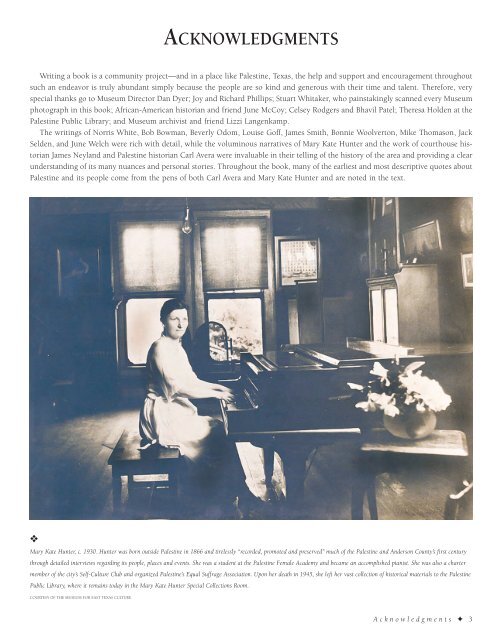Historic Palestine
An illustrated history of the Palestine, Texas area, paired with the histories of companies, families and organizations that make the region great.
An illustrated history of the Palestine, Texas area, paired with the histories of companies, families and organizations that make the region great.
You also want an ePaper? Increase the reach of your titles
YUMPU automatically turns print PDFs into web optimized ePapers that Google loves.
ACKNOWLEDGMENTS<br />
Writing a book is a community project—and in a place like <strong>Palestine</strong>, Texas, the help and support and encouragement throughout<br />
such an endeavor is truly abundant simply because the people are so kind and generous with their time and talent. Therefore, very<br />
special thanks go to Museum Director Dan Dyer; Joy and Richard Phillips; Stuart Whitaker, who painstakingly scanned every Museum<br />
photograph in this book; African-American historian and friend June McCoy; Celsey Rodgers and Bhavil Patel; Theresa Holden at the<br />
<strong>Palestine</strong> Public Library; and Museum archivist and friend Lizzi Langenkamp.<br />
The writings of Norris White, Bob Bowman, Beverly Odom, Louise Goff, James Smith, Bonnie Woolverton, Mike Thomason, Jack<br />
Selden, and June Welch were rich with detail, while the voluminous narratives of Mary Kate Hunter and the work of courthouse historian<br />
James Neyland and <strong>Palestine</strong> historian Carl Avera were invaluable in their telling of the history of the area and providing a clear<br />
understanding of its many nuances and personal stories. Throughout the book, many of the earliest and most descriptive quotes about<br />
<strong>Palestine</strong> and its people come from the pens of both Carl Avera and Mary Kate Hunter and are noted in the text.<br />
❖<br />
Mary Kate Hunter, c. 1930. Hunter was born outside <strong>Palestine</strong> in 1866 and tirelessly “recorded, promoted and preserved” much of the <strong>Palestine</strong> and Anderson County’s first century<br />
through detailed interviews regarding its people, places and events. She was a student at the <strong>Palestine</strong> Female Academy and became an accomplished pianist. She was also a charter<br />
member of the city’s Self-Culture Club and organized <strong>Palestine</strong>’s Equal Suffrage Association. Upon her death in 1945, she left her vast collection of historical materials to the <strong>Palestine</strong><br />
Public Library, where it remains today in the Mary Kate Hunter Special Collections Room.<br />
COURTESY OF THE MUSEUM FOR EAST TEXAS CULTURE.<br />
A c k n o w l e d g m e n t s ✦ 3
















